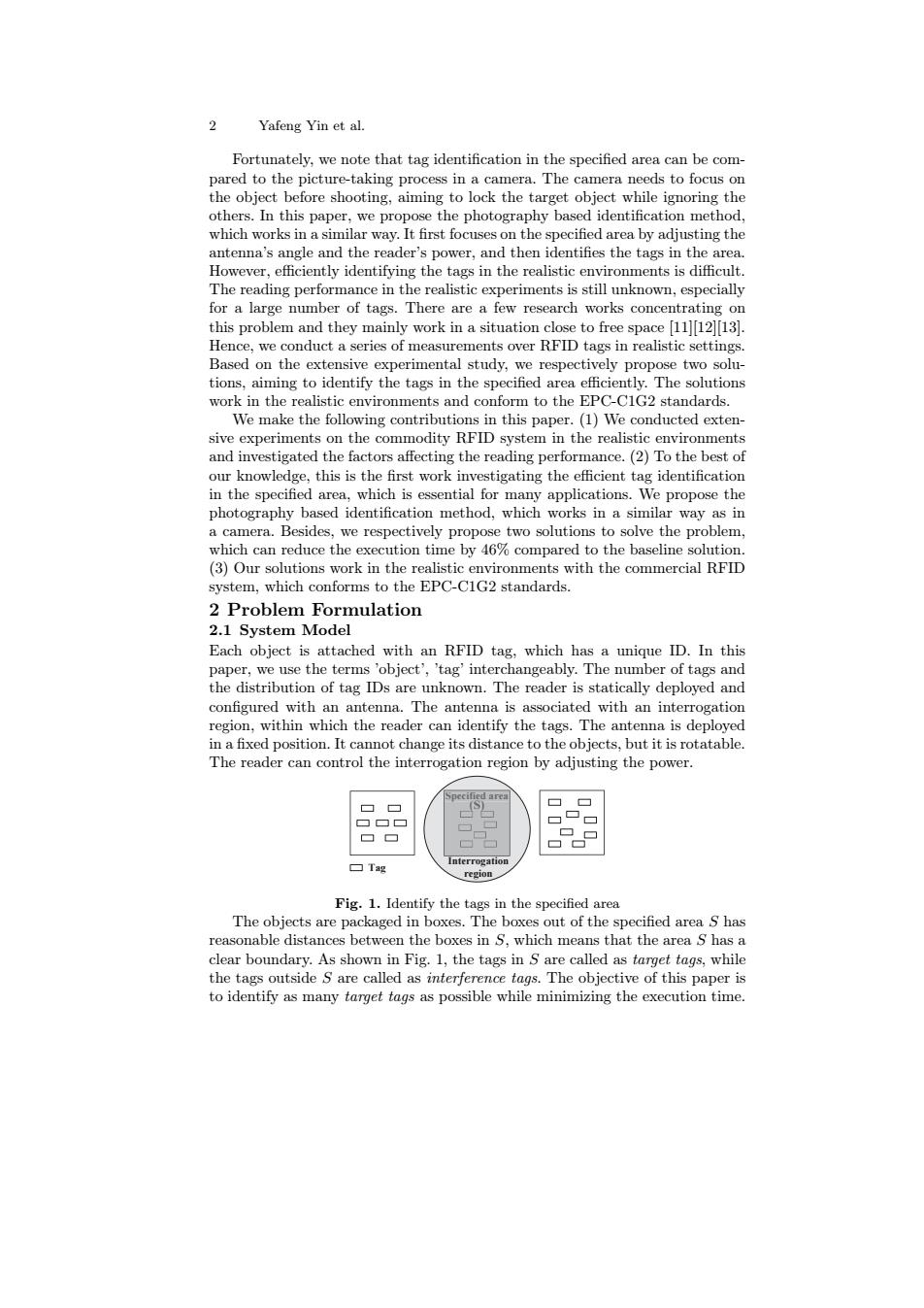正在加载图片...

2 Yafeng Yin et al. Fortunately,we note that tag identification in the specified area can be com- pared to the picture-taking process in a camera.The camera needs to focus on the object before shooting,aiming to lock the target object while ignoring the others.In this paper,we propose the photography based identification method, which works in a similar way.It first focuses on the specified area by adjusting the antenna's angle and the reader's power,and then identifies the tags in the area However,efficiently identifying the tags in the realistic environments is difficult. The reading performance in the realistic experiments is still unknown,especially for a large number of tags.There are a few research works concentrating on this problem and they mainly work in a situation close to free space [11][12][13] Hence,we conduct a series of measurements over RFID tags in realistic settings. Based on the extensive experimental study,we respectively propose two solu- tions,aiming to identify the tags in the specified area efficiently.The solutions work in the realistic environments and conform to the EPC-C1G2 standards. We make the following contributions in this paper.(1)We conducted exten- sive experiments on the commodity RFID system in the realistic environments and investigated the factors affecting the reading performance.(2)To the best of our knowledge,this is the first work investigating the efficient tag identification in the specified area,which is essential for many applications.We propose the photography based identification method,which works in a similar way as in a camera.Besides,we respectively propose two solutions to solve the problem, which can reduce the execution time by 46%compared to the baseline solution. (3)Our solutions work in the realistic environments with the commercial RFID system,which conforms to the EPC-C1G2 standards. 2 Problem Formulation 2.1 System Model Each object is attached with an RFID tag,which has a unique ID.In this paper,we use the terms 'object','tag'interchangeably.The number of tags and the distribution of tag IDs are unknown.The reader is statically deployed and configured with an antenna.The antenna is associated with an interrogation region,within which the reader can identify the tags.The antenna is deployed in a fixed position.It cannot change its distance to the objects,but it is rotatable The reader can control the interrogation region by adjusting the power. Interrogation ▣Tag region Fig.1.Identify the tags in the specified area The objects are packaged in boxes.The boxes out of the specified area S has reasonable distances between the boxes in S,which means that the area S has a clear boundary.As shown in Fig.1,the tags in S are called as target tags,while the tags outside S are called as interference tags.The objective of this paper is to identify as many target tags as possible while minimizing the execution time.2 Yafeng Yin et al. Fortunately, we note that tag identification in the specified area can be compared to the picture-taking process in a camera. The camera needs to focus on the object before shooting, aiming to lock the target object while ignoring the others. In this paper, we propose the photography based identification method, which works in a similar way. It first focuses on the specified area by adjusting the antenna’s angle and the reader’s power, and then identifies the tags in the area. However, efficiently identifying the tags in the realistic environments is difficult. The reading performance in the realistic experiments is still unknown, especially for a large number of tags. There are a few research works concentrating on this problem and they mainly work in a situation close to free space [11][12][13]. Hence, we conduct a series of measurements over RFID tags in realistic settings. Based on the extensive experimental study, we respectively propose two solutions, aiming to identify the tags in the specified area efficiently. The solutions work in the realistic environments and conform to the EPC-C1G2 standards. We make the following contributions in this paper. (1) We conducted extensive experiments on the commodity RFID system in the realistic environments and investigated the factors affecting the reading performance. (2) To the best of our knowledge, this is the first work investigating the efficient tag identification in the specified area, which is essential for many applications. We propose the photography based identification method, which works in a similar way as in a camera. Besides, we respectively propose two solutions to solve the problem, which can reduce the execution time by 46% compared to the baseline solution. (3) Our solutions work in the realistic environments with the commercial RFID system, which conforms to the EPC-C1G2 standards. 2 Problem Formulation 2.1 System Model Each object is attached with an RFID tag, which has a unique ID. In this paper, we use the terms ’object’, ’tag’ interchangeably. The number of tags and the distribution of tag IDs are unknown. The reader is statically deployed and configured with an antenna. The antenna is associated with an interrogation region, within which the reader can identify the tags. The antenna is deployed in a fixed position. It cannot change its distance to the objects, but it is rotatable. The reader can control the interrogation region by adjusting the power. Specified area Tag (S) Interrogation region Fig. 1. Identify the tags in the specified area The objects are packaged in boxes. The boxes out of the specified area S has reasonable distances between the boxes in S, which means that the area S has a clear boundary. As shown in Fig. 1, the tags in S are called as target tags, while the tags outside S are called as interference tags. The objective of this paper is to identify as many target tags as possible while minimizing the execution time